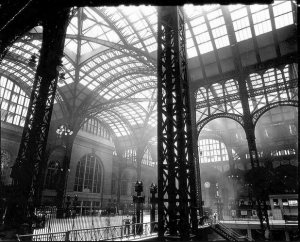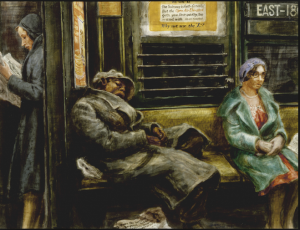Top 10 List
1. “Crossing Brooklyn Ferry”
Walt Whitman was definitely one of the best poets I think we read his semester. His views on transcenden talism and realism which are displayed in his poems really interested me. Whitman’s poem “Crossing Brooklyn Ferry” was only one poem from his poetry collection Leaves of Grass, published in 1855. The poem itself describes the journey across the East River, particularly from Manhattan to Brooklyn. I find this work so appealing because I can relate to the beauty Whitman had seen. When our class took the ferry across the East River, we all witnessed the beauty of New York in the same manner as Whitman.
talism and realism which are displayed in his poems really interested me. Whitman’s poem “Crossing Brooklyn Ferry” was only one poem from his poetry collection Leaves of Grass, published in 1855. The poem itself describes the journey across the East River, particularly from Manhattan to Brooklyn. I find this work so appealing because I can relate to the beauty Whitman had seen. When our class took the ferry across the East River, we all witnessed the beauty of New York in the same manner as Whitman.
2.“4’33″
Four thirty-three was a composition by famous composer John Cage. It was composed in 1952, and oddly enough was one of the weirdest but most interesting compositions I have ever heard. The performer, rather than actually playing any instruments or music, does the complete opposite and sits in complete silence. Rather, the “music” should be the voices of the audiences responding to composer’s performance. Although very controversial, Cage still believed that this work was his favorite and most influential. I too think the work was very different, but nonetheless interesting. Music should be different and everyone has different tastes, so I respect that Cage had the demeanor to try different types of music, even if they may seem outlandish.
3. “Lodgers in Bayard Street Tenement, Five Cents a Spot”
 Jacob Riis’ photographs were some of the most interesting, yet thought-provoking images I have seen all semester. Visualizing the manner how families were jammed inside their squalid tenements, I realized how hard it was to truly live in poverty in New York City. Riis was truly a social reformer who wanted to display the difficulties that were placed on people living in Tenements. His photograph “Lodgers in Bayard Street Tenement, Five Cents a Spot,” taken in 1889, shows how a large family is crammed into just one single room. The photograph is an iconic image that really stuck with me this whole semester.
Jacob Riis’ photographs were some of the most interesting, yet thought-provoking images I have seen all semester. Visualizing the manner how families were jammed inside their squalid tenements, I realized how hard it was to truly live in poverty in New York City. Riis was truly a social reformer who wanted to display the difficulties that were placed on people living in Tenements. His photograph “Lodgers in Bayard Street Tenement, Five Cents a Spot,” taken in 1889, shows how a large family is crammed into just one single room. The photograph is an iconic image that really stuck with me this whole semester.
4. “A-Tisket, A-Tasket”
Produced by Ella Fitzgerald, an American Jazz singer who is often referred as the “Queen of Jazz.” Although “A-Tisket, A-Tasket” was a famous nursery rhyme, her rendition of the nursery rhyme ultimately propelled her to fame. I enjoy the song due to the natural sound and excitement. The song is fast-paced and makes any listener to just stand up and start dancing. Fitzgerald’s voice is very soothing and goes perfectly with the song. It is no surprise to see the success that Fitzgerald garnered in her career and “A-Tisket, A-Tasket” just enhances her success more.
5. “The Oxbow View” (1836)
Thomas Cole, who lived during the early 19th century, was an English-born American artist. His works were famous for the amazing details that displayed sublime views of nature. Also regarded as the founder of the Hudson River School, an art movement we discussed during the beginning of the semester, I was intrigued by his painting “The Oxbow View,” which was produced in 1836. Just the details of his image expressing the beauty of nature and the wilderness really caused me to enjoy this painting so much.
6. ‘Ain’t Misbehavin’
Fats Waller was one of the most famous Jazz musicians during the 20th century. Known for fun-loving demeanor and funny faces made when performing his music, Waller’s composition for ‘Ain’t Misbehavin’, which was written in 1929, became an instant success. His piano playing and along with the sound of his voice in this piece really intrigued me to this piece. Just watching the music video and seeing everyone smiling and dancing to his performance highlights the happiness that Waller brought to people. Waller, although living a short life, accomplished so much and left his mark on Jazz music.
7. ‘Glassworks’
Philip Glass, born in 1937, is an American Composer and is still an influential music maker today. After a presentation on Glass during class, I became very interested in his music due to the different styles he projected in his works. I enjoyed a lot of his works, but I was most interested by his work Glassworks which is chamber music work of six movements. This piece was ultimately released as a 1982 studio album. Ultimately, it sounds so harmonious, and I really enjoyed the piece and Glass’ music in general.
8. ‘Pennsylvania Station’ (1936)
 Abbott’s photograph really captures the beauty of Penn Station. During our class visit to Penn Station, I was awed by its grandeur. Although Penn Station serves as transportation line for thousands of people a year, we tend to forgot the beauty of it. Penn Station is a remarkable architectural feat that all of New York should be proud of. Abbott really captures the beauty of Penn Station with her typical black and white image of it.
Abbott’s photograph really captures the beauty of Penn Station. During our class visit to Penn Station, I was awed by its grandeur. Although Penn Station serves as transportation line for thousands of people a year, we tend to forgot the beauty of it. Penn Station is a remarkable architectural feat that all of New York should be proud of. Abbott really captures the beauty of Penn Station with her typical black and white image of it.
9. Aida
 Aida was the first opera I had ever seen and had to make my top ten list. An opera of four parts that was first performed in 1871, Aida is truly a great spectacle because of not only the music, performances by the actors but also the scenery. I was awed by the artwork created for Aida, and really admired all the effort that was put into the work. The New York Metropolitan Opera theater is a fantastic place to watch any opera and really enhanced our class visit there.
Aida was the first opera I had ever seen and had to make my top ten list. An opera of four parts that was first performed in 1871, Aida is truly a great spectacle because of not only the music, performances by the actors but also the scenery. I was awed by the artwork created for Aida, and really admired all the effort that was put into the work. The New York Metropolitan Opera theater is a fantastic place to watch any opera and really enhanced our class visit there.
10. ‘Why Not Use the “L”?’ (1930)
 Reginald Marsh’s painting “Why Not Use the “L?”, published in 1930, during the midst of the Great Depression really captures the sadness that permeated New York City during the time. This painting displays perfectly the social justice that was so frequently talked about during our semester. Marsh shows the exhaustion and apathy that plagued New York City during the Great Depression because of the economic effects it had on everyone. Taking the train every day myself, this image has become a view seen too often, and I can relate to seeing tiring passengers daily.
Reginald Marsh’s painting “Why Not Use the “L?”, published in 1930, during the midst of the Great Depression really captures the sadness that permeated New York City during the time. This painting displays perfectly the social justice that was so frequently talked about during our semester. Marsh shows the exhaustion and apathy that plagued New York City during the Great Depression because of the economic effects it had on everyone. Taking the train every day myself, this image has become a view seen too often, and I can relate to seeing tiring passengers daily.

Leave a Reply